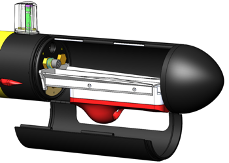RTSYS has integrated the RBRlegato3 C.T.D on the NemoSens© micro-AUV for low-power measurements of temperature, pressure, salinity, and sound velocity.
The NemoSens is a 90cm long micro-AUV and an evolution of the RTSYS range of larger AUVs. It is lightweight, easy-to-use, modular, and intended for water quality, hydrographic, and acoustic surveys, building on RTSYS’s years of acoustics experience. NemoSens uses low-power technology to operate for more than 12 hours at 3 knots and to a depth of 300m. Thanks to NemoSens open Linux architecture, scientists and commercial customers can develop their own detection algorithm to get the best from their exploratory campaigns using various payloads such as the RBRlegato3 C.T.D.
The RBRlegato3 has been selected as one of the first payloads to be integrated into the NemoSens as it suits many needs for scientific research and commercial surveys. A primary focus on mechanical integration was to make mounting and removing the C.T.D efficient for the customer. The integration goal was for the AUV diameter to remain the same and to achieve a flush, streamlined integration between the RBRlegato3 and the NemoSens.

The mechanical solution was to mount the RBRlegato3 on a rack in the wet-bay section of the nose-cone. Half of the nose-cone pivots open on a hinge to access the RBRlegato3. The connection is achieved with a direct connector-to-connector link, so no additional cable is required. This reduces the overall length of the final AUV.
The mounting solution doesn’t require the customer to buy a new AUV for each study. The sensor can be mounted and removed in the field without RTSYS assistance. RBRlegato3 C.T.D logs data to the onboard memory. Thanks to the serial communication between the RBRlegato3 and the AUV, all of the data logged during the mission are saved on the AUV memory and can be easily retrieved through Wi-Fi once NemoSens is recovered.